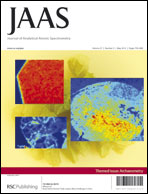Coupling between chip based isotachophoresis and multi-collector inductively coupled plasma mass spectrometry for separation and measurement of lanthanides
Abstract
This paper presents the conception and fabrication of a microsystem for lanthanides separation and its coupling with a multicollector inductively coupled plasma mass spectrometer for isotope ratio measurements. The lanthanides separation is based on the isotachophoresis technique and the microsystem conception has been adapted in order to fit with glove box limitations in view of future spent


 Please wait while we load your content...
Please wait while we load your content...